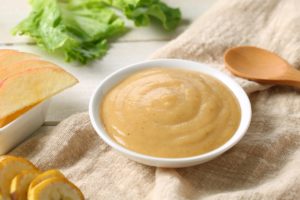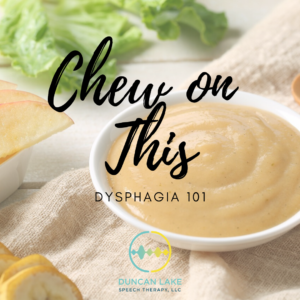If you were shocked when I wrote that SLPs help people with their swallowing, you aren’t alone! When I started graduate school, I had no idea that this fell within the realm of speech pathology. So, you’re in good company!
Dysphagia is a very official and fancy term for “swallowing disorder.” The disorder can occur as a result of something going on in the mouth (oral cavity) or in the throat (pharyngeal cavity). It can also occur as a result of something going on in the stomach, but we leave that to the GI doctors (I know nothing about stomachs). Either way, food and liquids are not making their way properly to the stomach. Sometimes it escapes out of the mouth and other times, it escapes into the lungs.

This is an important topic for many reasons, but largely because it’s not well known and it’s often under diagnosed. So let me hit you with some knowledge!
CAUSE
Dysphagia can occur in both adults and children. In adults, it can be a result of a stroke, head/neck injury, head/neck cancer, neurodegenerative diseases (i.e. dementia, Parkinson’s, etc.), missing teeth, intubation, or any variety of medical conditions. In kiddos, it is generally a result of a medical condition or structural abnormality. Some behavioral factors may contribute in some cases. Our SLP and OT friends in the NICU have an extremely specialized set of skills working with tiny babies on feeding.
Sometimes, people just have dysphagia as a result of age. My grandfather was diagnosed with dysphagia with no underlying medical conditions. He was, however, in his 90s. Structures related to eating and drinking can become weak as one’s age progresses, which can cause dysphagia.
SIGNS
While each presentation of dysphagia is different, the typical signs are:
-
Coughing during or shortly after eating or drinking
-
Gurgly voice quality during or shortly after eating or drinking
-
Complaint of pain while swallowing
-
Feeling like something is “stuck” in the throat
-
Difficulty chewing or extremely slow chewing
-
Runny nose after eating or drinking
-
Inability to keep food or liquid in mouth
-
Fever following eating or drinking
-
Decrease in consumption of food or drink as a result of pain or effort relating to eating/drinking resulting in weight loss or dehydration
One of these symptoms alone does not mean an individual has dysphagia. It’s a big-picture situation rather than one individual symptom.
DIAGNOSIS
If you have concerns about a loved one, make sure to bring it up to their primary care provider. They will refer the loved one to a speech-language pathologist (hooray!) who will conduct a video swallow study of some variety. They will monitor your loved one while eating and drinking different textures of food and beverages. If you want to see a “normal” swallow video study, take a look here!
A lot of times, if a person comes to a hospital following a major medical incident (i.e. stroke, car accident, injury), part of the protocol is for an SLP to do a bedside swallow evaluation right away. They may make a request to the doctor to do a swallow study based on what they see.
After a study is complete, a diagnosis can be made.
TREAMENT
SLPs work with patients with dysphagia using a lot of different strategies. The main goal is to try to get the patient to a place where they can safely eat normal food. Until that point, several precautions are put into place.
 Dietary changes: SLPs may require an individual to change their diet to either mechanical soft (think PJ&J sandwiches), mechanical chopped (really finely chopped up food), or pureed food (think baby food consistency). Liquids can be nectar thick (like a thicker fruit juice), honey thick (like honey), or thick (which requires a significant thickening agent). As you can imagine, it’s not super fun for the patient. SLPs trial different consistencies of foods and liquids to see how well a patient tolerates them.
Dietary changes: SLPs may require an individual to change their diet to either mechanical soft (think PJ&J sandwiches), mechanical chopped (really finely chopped up food), or pureed food (think baby food consistency). Liquids can be nectar thick (like a thicker fruit juice), honey thick (like honey), or thick (which requires a significant thickening agent). As you can imagine, it’s not super fun for the patient. SLPs trial different consistencies of foods and liquids to see how well a patient tolerates them.
-
Strategies: SLPs work with patients on safe eating strategies such as positioning in bed, bite size, straw use, and focus. They may also have the family help the patient eat. Our friends the OTs provide strategies for the physical aspects of eating and drinking (modified utensils).
-
Exercises: For patients who are able, SLPs can teach them exercises and maneuvers to utilize during swallowing to ensure that they don’t choke. I won’t go into details about this because they’re really intricate, but believe me, they exist. This requires a patient to be able to follow through on the directions or to have family members help them.
The overall goal is to make sure that the patient is SAFE – no choking, no liquids or foods going into the lungs, and staying nourished.
WHY IS THIS EVEN IMPORTANT?
Diagnosing dysphagia is extremely important for a variety of reasons. Undiagnosed swallowing disorders can lead to choking, pneumonia, and extreme malnutrition or dehydration. Treatment is equally as important! Once a diagnosis occurs, treatment should commence to ensure safety and to help return the person to their favorite foods. Can you imagine not being able to eat pizza? Or chocolate? Instead, imagine eating a pureed version of it. NOT ENJOYABLE! Food and drink are central to any culture. If we take that away from people, think about how depressing that would be.
If you have concerns about a loved one, contact their primary care provider. You can also talk to your friendly, neighborhood SLP about it. 🙂 They’ll point you in the right direction.

